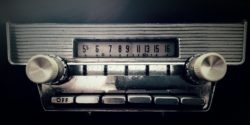A number of months ago I was scanning around the AM dial late in the evening from my Portland, Oregon abode. I stumbled upon a station playing hard rock, which I thought to be an unusual find. As the AM dial has become mostly the domain of conservative and sports talk, I rarely encounter music that isn’t a bumper or part of some leased-time foreign-language programming.
In fact, at first I thought perhaps the music was a lead-in to just another talk show, but eventually I heard a full set of three songs. The station identified itself as “The Bear,” but curiously gave an FM frequency, not one on the AM dial.
An internet search the next day confirmed that “the Bear” is indeed an active rock formatted station located in Merced, California. Its logo features 105.7 FM prominently, with the 1660 AM frequency tucked in the corner. Yet, the AM signal is actually the primary one – the FM is a 250 watt repeater (translator) station.
Here’s a quick aircheck of the Bear’s station ID, during a break in the syndicated hard rock “Loudwire” program.
Now, AM stations have been permitted to get FM translators for a few years now as part of the FCC’s so-called “AM revitalization” initiative. But mostly I’ve heard sports and news/talk stations get repeated on FM.
I filed away this experience in memory, but kind of considered it a one-off. That was until my recent vacation in the Wallowa Mountains of Northeastern Oregon. Stowed away and social distancing in a mountainside cabin with limited internet and no cable, I spent quite a bit of time scanning the AM and shortwave bands in search of interesting sounds.
This time I heard a full set of contemporary hip-hop. At the break the station identified as “The Game, nothing but hip-hop.” After the commercial break, the next ID gave a frequency of 103.5 FM. Listening for about 45 minutes while I made dinner, I never heard the AM frequency mentioned once.
Here is a short aircheck of two station IDs for “The Game.”
“The Game” was coming to me out of Spokane, Washington, 200 miles north of my Joseph, Oregon location. A later search also identified KGA as an AM station, first licensed in 1927, with translator at 103.5 FM. Unlike “the Bear,” branding for “the Game” has no indication of its AM signal. The station’s website curiously makes no mention of AM, either.
For “the Game” it really seems like the AM signal – with a powerful 50,000 watt daytime power – is just a feeder for an FM that broadcasts with less than 1% the power. Granted, I get that few hip-hop fans are likely to scan the AM dial looking for the station, but they might give it a try if they knew about it – especially if they’re on the fringe or outside the FM’s constrained broadcast radius.
It’s refreshing to hear music on the AM band that isn’t being used as a bumper or bed, and isn’t easy listening. But it’s also a little disheartening to realize that it’s likely few listeners actually tune in to the AM signal.
December 2020 ratings for the Spokane market still list KGA as a sports talk station, ranking at #22 out of 26 stations in the book. Only the AM frequency is listed, and I’m not entirely sure they’d list the FM frequency, too. So there’s no way to really tell which signal has the listeners.
Merced, home to “the Bear,” is no longer measured by Nielsen, and the new ratings company doesn’t share their rankings online.
With most medium-to-large market FM dials packed to the gills, it only makes sense that some enterprising AM operators would try music as a way to better leverage their FM translators. I understand this has become a bit of a tiny trend, though I’ve not been able to figure out just how widespread.
It seems like music on AM may get even another boost, thanks to the FCC’s authorization of all-digital HD Radio on the dial in October. Stations that already use hybrid HD Radio – where the digital signal is squeezed in next to the analog one – have higher fidelity when received on an HD-capable receiver. Because more bandwidth will be dedicated to the digital signal, all-digital AM stations should have even better sound quality.
In December, Radio World reported on KMZT-AM in Southern California, which actually flipped from oldies to classical music on its hybrid HD signal. The programming is also heard on the HD–4 channel of a co-owned FM station. The owner says he’ll consider switching to all-digital when there are more HD receivers in use.
The downside to all-digital AM is that analog receivers – the vast majority of AM radios that aren’t in cars – won’t be able to hear these signals. That is, of course, unless these stations also have FM translators.
I imagine AM stations that have these translators will be some of those more willing to take the risk of trying all-digital AM, since they can still reach analog listeners on the other dial. At the same time, the tiny broadcast areas of translators mean that the potential audience will be smaller, at least in the daytime, when many AM stations run at full power.
Only one AM station so far has filed paperwork to go all-digital, WMGG-AM in Egypt Lake, Florida. It is simulcast on both a full-power FM and an FM translator.
Even though many of the largest radio owners have signaled little interest in all-digital AM, it should still be a fascinating year for the dial. I’ll be on the lookout for more music formats cropping up. Let us know if you hear anything interesting.
Feature image credit: Michael Curi / flickr (CC BY 2.0)



